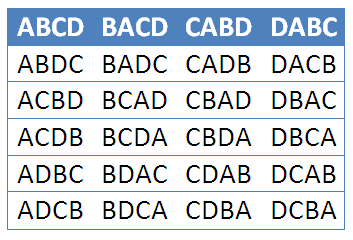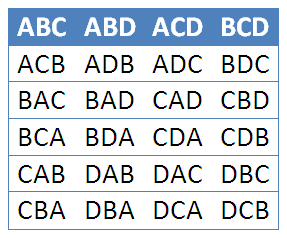Introduction to Combinations
In my Introduction to Permutations post, we have learned that the number of permutations (or arrangements) of  objects taken at
objects taken at  at a time written as
at a time written as  is equal to
is equal to  , and we have also learned that the number of permutations of
, and we have also learned that the number of permutations of  objects taken
objects taken  at a time written as
at a time written as  is equal to
is equal to  .
.
In Figure 1, shown are the permutations of  letters, A, B, C and D taken
letters, A, B, C and D taken  at a time. From the figure, we can see that there are indeed
at a time. From the figure, we can see that there are indeed  of such arrangement. In Figure 2, shown are the permutations of
of such arrangement. In Figure 2, shown are the permutations of  letters taken
letters taken  at a time, and we have shown that the number of permutations is equal to
at a time, and we have shown that the number of permutations is equal to  . In Figure 3, we have again listed the permutations of
. In Figure 3, we have again listed the permutations of  letters taken
letters taken  at a time, and have shown that the number of permutations is equal to
at a time, and have shown that the number of permutations is equal to  .
.

Figure 1 – Permutations of ABCD, taken 4 at a time.

Figure 2 – Permutations of ABCD, taken 3 at a time.

Figure 3 – Permutations of ABCD, taken 2 at a time.
If we talk about combinations, however, the arrangement of objects does not matter. For example, if we want to buy a milk shake and we are allowed to choose to combine any  flavors from Apple, Banana, Cherry and Durian*, then the combination of Apple, Banana and Cherry is the same as the combination Cherry, Apple, Banana.
flavors from Apple, Banana, Cherry and Durian*, then the combination of Apple, Banana and Cherry is the same as the combination Cherry, Apple, Banana.
Try to list all the possible combinations of  flavors taken from
flavors taken from  before proceeding.
before proceeding.
If we choose to shorten the name the fruits by selecting the first letter of their names, we only have  possible combinations for question above: ABC, ABD, ACD, and BCD. Notice that these are the only possible combinations. Also, observe that if we list the permutations of ABC, we have ACB, BAC,BCA, CAB and CBA. This means that in permutations, we have counted each combination of
possible combinations for question above: ABC, ABD, ACD, and BCD. Notice that these are the only possible combinations. Also, observe that if we list the permutations of ABC, we have ACB, BAC,BCA, CAB and CBA. This means that in permutations, we have counted each combination of  flavors from
flavors from  flavors
flavors  times (or
times (or  times instead of one.
times instead of one.
In other words, a combination is just like a subgroup of a group. For instance, if we want to find the number of subgroups containing  objects taken from
objects taken from  objects (or the combination of
objects (or the combination of  objects taken
objects taken  at a time), it is the same as asking “how many possible groups of
at a time), it is the same as asking “how many possible groups of  objects can be taken from
objects can be taken from  objects?” In Figure 4, all the possible subgroups of
objects?” In Figure 4, all the possible subgroups of  letters taken from
letters taken from  letters are displayed by the orange border. You also would have realized that the number of permutations is an overcounting of the number of combinations.
letters are displayed by the orange border. You also would have realized that the number of permutations is an overcounting of the number of combinations.

Figure 4 – The combinations of 4 objects taken 3 at a time is the same as the number of subgroups of 3 objects taken from 4 objects.
In Figure 2, ABC, ACB, BAC, BCA, CAB and CBA are permutations of Apples, Banana and Cherry. For each subgroup of  , we realized that we counted
, we realized that we counted  times. So, to get the number of combinations, we divide our number of permutations
times. So, to get the number of combinations, we divide our number of permutations  by the number of permutations of our subgroup
by the number of permutations of our subgroup . Therefore, we can say that the number of combinations of
. Therefore, we can say that the number of combinations of  objects taken
objects taken  at a time is equal to
at a time is equal to

In general, to get the number of combinations of  objects taken
objects taken  at a time, we have to divide the number of permutations of
at a time, we have to divide the number of permutations of  by the number of permutations of the subgroup
by the number of permutations of the subgroup  .
.

The combinations of  objects taken
objects taken  is usually denoted by
is usually denoted by  or
or 
_____________________________________________________________
*Durian is a fruit which can be found in the Philippines. It looks like a jackfruit.




